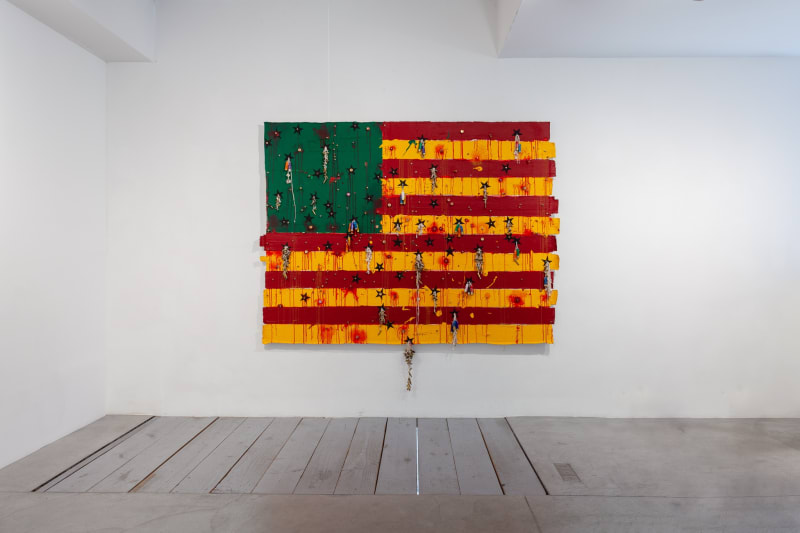Galerie Nathalie Obadia is pleased to present Homo Imparfaits, Nú Barreto’s first solo show in Brussels.
Born in 1966 in São Domingos, Guinea-Bissau, Nú Barreto has been living and working in Paris since 1989. Chosen to represent his country at the Lisbon World Fair of 1998, the artist has since then received international exposure and established himself as one of the most prominent artists of African contemporary art.
Nú Barreto exhibited in Belgium for the first time in 2006 for the group show entitled Afrique-Europe: rêves croisés organized by the European Commission 1.
For this new exhibition, the Guinean artist is presenting a series of exclusive drawings along with several paintings from his famous États Désunis d’Afrique series started in 2009. All the exhibited artworks faithfully reflect Nú Barreto’s political engagement. They describe the evils of contemporary African society while also rekindling the hope that Africa frees itself from its past to invent a new future.
Drawing has been Nú Barreto’s favorite medium since childhood. Children would come from neighboring villages to see his drawings, which were the pride of his parents. His works on paper have kept the imaginative liveliness of that time; but they now serve the story of his personal experience of contemporary Africa. And the artist is not complacent. Most of the time, he is bitter and fierce. With his sharp pencils and bloody red paint, Nú Barreto depicts the violence that marked the African continent.
In the midst of this daily reality, Nú Barreto’s homo imperfect plays the lead role. Like a mirror, this black and red ink alter ego bring us back to our own inconsistency and confronts us to our responsibility toward Africa’s current situation.
The homo imperfect is aptly named. His body is distorted by pain and fear. According to the artist, his screaming mouth bears witness of the daily suffering of the African people as well as its collective memory. In that regard, artist Francis Bacon, which paintings so masterfully captured suffering, is a claimed source of inspiration for Nú Barreto, who also mentions Lucian Freud, Willem de Kooning as well as Portuguese painter Paula Rego among his pantheon of reference artists. He borrowed from the latter the subtle blend of realism and symbolism she used for her social satire.
The absence of background or spatial reference in Nú Barreto’s compositions conveys a strong feeling of dizziness. Like a funambulist, the homo imperfect balances himself on the thread that cut through many of his drawings. In the artist symbolic system, this thread represents the “lifeline”, and its recurrence points to the precariousness of existence as much as its permanence.
Other fetish objects, like chairs and ladders, reappear from drawings to drawings. The first one, with its broken leg, symbolizes the chronic instability of African states. The second, with its broken rungs, is a metaphor for the social mobility which stalling contributes to the rise of inequality. Nú Barreto’s collection of symbols also includes animals (crows, pigs, chameleons etc.) and obsolete objects like bikes and guitars. On an even stranger note, it rains bananas, nails and even umbrellas, both open and closed. This wide variety of symbols draws from West African aboriginal cultures, which artistic production also resorted to the power of signs. To complete this personal semantic, the artist makes an impressionist use of the red color he has chosen for its symbolic power. Papers, whether lacerated or ripped off, also play a role in the depiction of the tormented landscape the homo imperfect is creating at his own image. The various iconographic and plastic resources that Nú Barreto uses in his works on paper all contribute to their strong evocative and emotional power, similar to the drawings of South-African artist William Kentridge.
The exhibited large format paintings are part of his États Désunis d’Afrique series. By changing the colors of the American star spangled flag into red, yellow and green, the three most recurring colors in the flags of the fifty-four African states, the artist emphasizes the disunion of his people he holds responsible for the evils of African societies. According to him, their inability to pull in the same direction is the cause of their dependence towards foreign powers. The black stars anarchically scattered on the shredded strips of Nú Barreto’s Pan-African flags reflect the situation he denounces.
Despite the critical content of his work, the artist continues to have an unfailing trust in men, especially in his homo imperfect, which flaws he likes to ridicule in order for him to correct them. This virtuous power of art has inspired the artist deeply hopeful artworks like La Source, in which each star hangs a book written by an African author. These books alone symbolize the entire intellectual and cultural wealth of African nations. A metaphorical way for the artist to tell his contemporaries that Africa should, and can, take fate into its own hands.
1. Afrique-Europe : rêves croisés is an exhibition of contemporary African art organized by the European Commission for the European Development Days at Les Atelier des Tanneurs, November 13-December 10, 2006, Brussels, Belgium.

